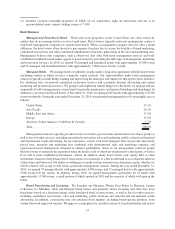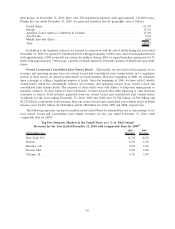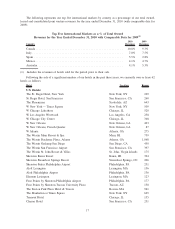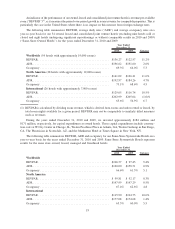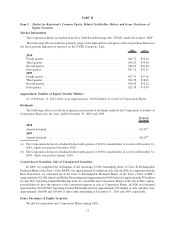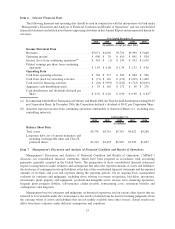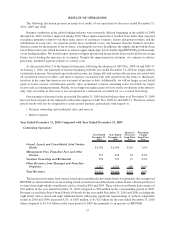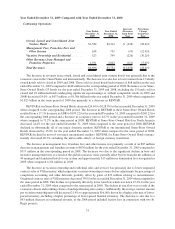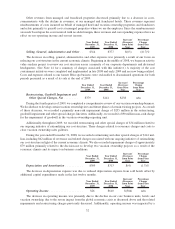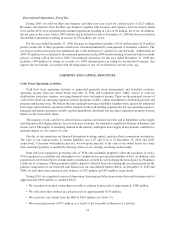Starwood 2010 Annual Report Download - page 93
Download and view the complete annual report
Please find page 93 of the 2010 Starwood annual report below. You can navigate through the pages in the report by either clicking on the pages listed below, or by using the keyword search tool below to find specific information within the annual report.Goodwill and Intangible Assets. Goodwill and intangible assets arise in connection with acquisitions,
including the acquisition of management contracts. We do not amortize goodwill and intangible assets with
indefinite lives. Intangible assets with finite lives are amortized on a straight-line basis over their respective useful
lives. We review all goodwill and intangible assets for impairment by comparing their fair values to book values
annually, or upon the occurrence of a trigger event. Impairment charges, if any, are recognized in operating results.
Frequent Guest Program. SPG is our frequent guest incentive marketing program. SPG members earn
points based on spending at our owned, managed and franchised hotels, as incentives to first-time buyers of VOIs
and residences, and through participation in affiliated partners’ programs such as co-branded credit cards. Points
can be redeemed at substantially all of our owned, managed and franchised hotels as well as through other
redemption opportunities with third parties, such as conversion to airline miles.
We charge our owned, managed and franchised hotels the cost of operating the SPG program, including the
estimated cost of our future redemption obligation, based on a percentage of our SPG members’ qualified
expenditures. The Company’s management and franchise agreements require that we be reimbursed for the costs of
operating the SPG program, including marketing, promotions and communications and performing member
services for the SPG members. As points are earned, the Company increases the SPG point liability for the amount
of cash it receives from its managed and franchised hotels related to the future redemption obligation. For its owned
hotels we record an expense for the amount of our future redemption obligation with the offset to the SPG point
liability. When points are redeemed by the SPG members, the hotels recognize revenue and the SPG point liability is
reduced.
We, through the services of third-party actuarial analysts, determine the value of the future redemption
obligation based on statistical formulas which project the timing of future point redemptions based on historical
experience, including an estimate of the “breakage” for points that will never be redeemed, and an estimate of the
points that will eventually be redeemed as well as the cost of reimbursing hotels and other third parties in respect of
other redemption opportunities for point redemptions.
We consolidate the assets and liabilities of the SPG program including the liability associated with the future
redemption obligation which is included in other long-term liabilities and accrued expenses in the accompanying
consolidated balance sheets. The total actuarially determined liability (see Note 18), as of December 31, 2010 and
2009 is $753 million and $689 million, respectively, of which $225 million and $244 million, respectively, is
included in accrued expenses.
Long-Lived Assets. We evaluate the carrying value of our long-lived assets for impairment by comparing the
expected undiscounted future cash flows of the assets to the net book value of the assets if certain trigger events
occur. If the expected undiscounted future cash flows are less than the net book value of the assets, the excess of the
net book value over the estimated fair value is charged to current earnings. Fair value is based upon discounted cash
flows of the assets at a rate deemed reasonable for the type of asset and prevailing market conditions, sales of similar
assets, appraisals and, if appropriate, current estimated net sales proceeds from pending offers. We evaluate the
carrying value of our long-lived assets based on our plans, at the time, for such assets and such qualitative factors as
future development in the surrounding area, status of expected local competition and projected incremental income
from renovations. Changes to our plans, including a decision to dispose of or change the intended use of an asset,
can have a material impact on the carrying value of the asset.
Loan Loss Reserves. For the vacation ownership and residential segment, we record an estimate of expected
uncollectibility on our VOI notes receivable as a reduction of revenue at the time we recognize a timeshare sale. We
hold large amounts of homogeneous VOI notes receivable and therefore assess uncollectibility based on pools of
receivables. In estimating loan loss reserves, we use a technique referred to as static pool analysis, which tracks
defaults for each year’s mortgage originations over the life of the respective notes and projects an estimated default
rate. As of December 31, 2010, the average estimated default rate for our pools of receivables was 10%.
The primary credit quality indicator used by us to calculate the loan loss reserve for the vacation ownership
notes is the origination of the notes by brand (Sheraton, Westin, and Other) as we believe there is a relationship
between the default behavior of borrowers and the brand associated with the vacation ownership property they have
acquired. In addition to quantitatively calculating the loan loss reserve based on its static pool analysis, we
25


